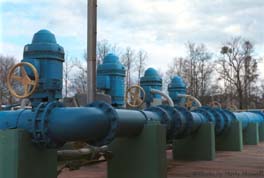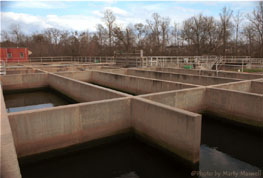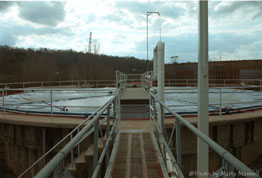| page last updated |
 |
River Tour | Estuary | Salt Marsh | |
| What is an Estuary? > Climate > Geology > Surface Water > Ground Water > Aquatic Habitat > Upland Habitat > Ecological Processes > Animals and Plants > Socioeconomic Values > Human Impacts and Pollution > Where does Your water come from? > Management Issues > Protecting YOUR Watershed | ||
|
K-12
Students Site
|
||
| Where does YOUR water come from? > Surface Water > Groundwater > Water Treatment | |||||
|
Water treatment facilities are places that filter and disinfect water. They are usually located along rivers. Drinking Water Treatment Facilities Drinking Water Treatment Facilities clean freshwater intended for drinking. Depending on where you live, your drinking water may come from rivers or lakes (surface water), or from freshwater below the ground (groundwater). See Where Does YOUR Water Come From? for more information. Before you can use or drink freshwater from the environment, it must be cleaned to protect your health. Drinking Water Treatment Facilities remove sediment pollution, chemical pollution, and disease pollution from the water. After the water is cleaned, it is sent to homes, schools, and businesses through pipes underground. When you turn on a faucet, this is where your water has come from! Drinking Water Treatment Facilities are often located along rivers because rivers are a common source of freshwater for drinking. Water is withdrawn from the river and pumped into the facility for cleaning. Wastewater Treatment Facilities Once water has been used, whether it has been flushed down a toilet, gone down the kitchen sink, or used for laundry, it becomes wastewater (also called sewage). Wastewater must be cleaned to remove chemicals and waste. Wastewater is pumped from homes to Wastewater Treatment Facilities for cleaning through pipes underground. After wastewater is cleaned, it is released back into the environment. Treated wastewater is usually released into a river. This is why Wastewater Treatment Facilities are often located on rivers. Cleaning wastewater protects the health of animals and plants in the environment from different types of pollution. How Water
is Cleaned Water is cleaned in two (2) steps: 1) the water is filtered, and 2) the water is disinfected. Wastewater Treatment Facilities put most of their effort into filtering the wastewater (step 1). Wastewater arrives at the facility as thick sludge. Below is a diagram showing how the chunks of sewage are separated from the water. The sewage is dried and can be re-used as fertilizer. The water is treated and released into the environment. Drinking Water Treatment Facilities put most of their effort into disinfecting the water (step 2). It is important to get the water really clean because it is going to be used for drinking, cooking, bathing, and cleaning. Freshwater intended for drinking is already cleaner than wastewater. The freshwater is filtered through screens to remove small particles. Then, special care is taken to disinfect the water. Chlorine is usually added to kill any microorganisms, such as bacteria, that may cause disease. We All Live
Upstream (and Downstream!) of Wastewater Treatment Facilities But wait… We all live downstream from some other city! (And someone lives downstream from us!) This means that our drinking water source contains treated wastewater from the cities upstream of us. (And, our treated wastewater flows downstream into other people's drinking water sources!) Remember, we are all connected by water. Actions that keep our water supply clean (or dirty it!) affect us all.
|
 |
||||
 |
|||||
 |
|||||